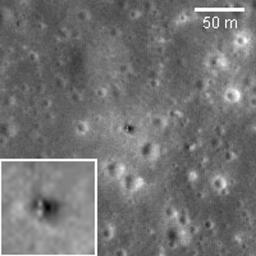
|
Luna 16
- Click the image above for a larger view
- Full-Res JPEG (900 x 900) (55.0 kB)
- Full-Res TIFF (900 x 900) (811.0 kB)
Caption:
Luna 16 was the first robotic mission to land on the Moon and return a sample to the Earth. It was launched by the Soviet Union on 12 September 1970; landed on the Moon on 20 September; lifted off on 21 September and returned to the Earth on 24 September. The lunar landing occurred on the basaltic plains of Mare Fecunditatis; about 101 grams (3.5 ounces) of lunar material were returned. Sampling operations were conducted entirely in the dark since the Sun had already set when Luna 16 touched down.
Background Info:
NASA's Goddard Space Flight Center built and manages the mission for the Exploration Systems Mission Directorate at NASA Headquarters in Washington. The Lunar Reconnaissance Orbiter Camera was designed to acquire data for landing site certification and to conduct polar illumination studies and global mapping. Operated by Arizona State University, LROC consists of a pair of narrow-angle cameras (NAC) and a single wide-angle camera (WAC). The mission is expected to return over 70 terabytes of image data.
Cataloging Keywords:
| Name | Value | Additional Values |
|---|---|---|
| Target | Moon | |
| System | Earth | |
| Target Type | Satellite | |
| Mission | Lunar Reconnaissance Orbiter (LRO) | |
| Instrument Host | Lunar Reconnaissance Orbiter | |
| Host Type | Orbiter | |
| Instrument | Lunar Reconnaissance Orbiter Camera (NAC) | |
| Detector | Narrow Angle Camera (NAC), Wide Angle Camera (WAC) | |
| Extra Keywords | Grayscale | |
| Acquisition Date | ||
| Release Date | 2010-03-25 | |
| Date in Caption | 1970-09-12 | |
| Image Credit | NASA/GSFC/Arizona State University | |
| Source | photojournal.jpl.nasa.gov/catalog/PIA12984 | |
| Identifier | PIA12984 | |
